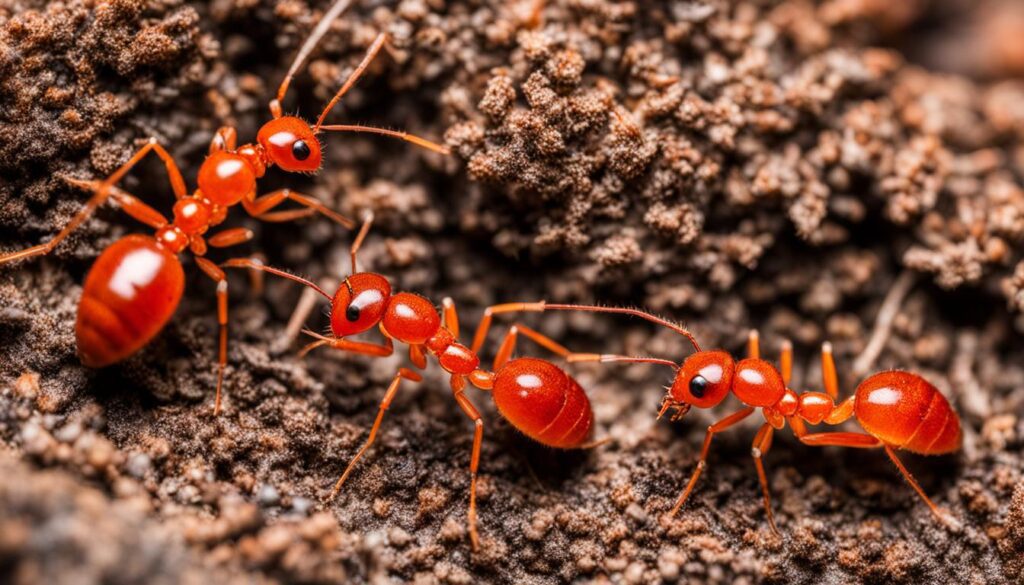Red ants and fire ants may look similar, but there are distinct characteristics that set them apart. It’s important to be able to identify and differentiate between these two species in order to effectively manage and control them in your environment. While both ants can cause discomfort and annoyance, understanding their differences can help you take appropriate actions to deal with them.
Key Takeaways:
- Red ants and fire ants have noticeable differences in size, appearance, nesting behavior, aggressiveness, diet, and sting sensation.
- Red ants are typically found in the southeastern United States, while fire ants are native to South America and have become invasive pests in the southern United States and other parts of the world.
- Identifying the specific type of ant infestation in your backyard is crucial for effective pest management and control.
- Consulting a professional pest control service can provide a thorough inspection and treatment plan for red ant or fire ant infestations.
- Taking preventive measures such as eliminating food sources, sealing entry points, and conducting regular inspections can help protect your home from both red ants and fire ants.
Characteristics and Appearance
When it comes to the characteristics and appearance of red ants and fire ants, there are some key differences to consider. Red ants, also known as “red imported fire ants,” typically measure between 1/16 to 1/5 inch in length. They have a two-segmented body and a noticeable narrowing, or “waist,” between the thorax and abdomen.
On the other hand, fire ants are similar in size, ranging from 1/16 to 1/4 inch. Both red ants and fire ants can vary in color, but fire ants are generally more aggressive in behavior.
Nesting Behavior and Characteristics
Red ants and fire ants display distinct nesting behaviors and characteristics. Understanding these differences can help you identify and address infestations more effectively.
Red Ant Nests
Red ants prefer to build their nests in soil, creating intricate underground tunnels and chambers. Their nests are typically shallow and less conspicuous compared to the mounds created by fire ants.
Fire Ant Mounds
On the other hand, fire ants construct large, cone-shaped mounds made of loose soil. These mounds can reach impressive heights of up to 18 inches, making them a distinctive feature of fire ant colonies. Fire ant mounds are commonly found in moist areas, often appearing after rainfall.
This image showcases the typical appearance of fire ant mounds, which are different from the nests built by red ants.
Understanding the nesting habits of red ants and fire ants is crucial for effective pest management. By identifying the type of colony and its specific nesting characteristics, you can implement appropriate control strategies to minimize the impact of these pests.
Aggressiveness and Range
When it comes to aggression, red ants and fire ants exhibit different behaviors. While red ants do have the ability to bite and sting, they are generally less aggressive compared to their fiery counterparts. Fire ants, on the other hand, are known for their aggressive nature and will not hesitate to attack any intruder that poses a threat to their nest.
Fire ants have a well-structured and highly organized social system within their nests, which contributes to their aggressive behavior. They are highly territorial and fiercely defend their colonies from perceived threats. Any unfortunate soul that unknowingly steps too close to a fire ant mound can expect a rapid and aggressive response.
In terms of range, red ants are primarily found in the southeastern United States, but their territory has expanded to other parts of the country as well. On the other hand, fire ants are native to South America and have become invasive pests in the southern United States and other regions around the world.
Understanding the aggressiveness and range of red ants and fire ants is crucial in managing and dealing with these pests effectively. While red ants may be less aggressive, it is still important to take precautions and protect yourself when dealing with any species of ants. If you’re facing a severe ant infestation, it’s advisable to consult a professional pest control service for assistance in controlling and eliminating these pests from your property.
Diet and Sting Sensation
When it comes to their diet, red ants and fire ants have distinct preferences and feeding habits. Red ants are omnivorous creatures, feeding on a variety of insects, small animals, and plant matter. They have a diverse diet and are less likely to scavenge for food compared to their counterparts. On the other hand, fire ants are highly aggressive predators and scavengers. They have a voracious appetite and will not hesitate to attack and kill small animals, including insects and even small vertebrates.
When it comes to their sting sensation, the experiences differ between red ants and fire ants. While red ant stings can be painful, they are usually not as severe as fire ant stings. Fire ant stings, on the other hand, deliver a painful and burning sensation that can cause intense pain, itching, and discomfort. In some cases, fire ant stings can even result in pus-filled blisters, adding to the discomfort and irritation they cause.
It is important to be cautious around both red ants and fire ants to minimize the risk of getting stung. If you happen to encounter these insects, it is best to keep a safe distance and avoid any unnecessary interactions. In case of a sting, it is recommended to seek appropriate medical attention and take necessary steps to alleviate the pain and discomfort caused by the sting.
What are the Specific Characteristics of Fire Ants That Make Them More Difficult to Get Rid of in the Yard?
Fire ants are particularly difficult to eliminate from a yard due to their aggressive nature and resilient colonies. These ants have the ability to quickly adapt to chemical treatments, making it necessary to employ effective natural strategies for ants such as using diatomaceous earth or creating barriers with substances like cinnamon or vinegar.
Conclusion
In conclusion, understanding the differences between red ants and fire ants is crucial for effective pest management and control. By being able to identify and distinguish these two species, you can take appropriate actions to deal with them in your backyard.
To successfully manage red ants and fire ants, it is recommended that you consult a professional pest control service for a thorough inspection and treatment plan. These experts have the knowledge and expertise to handle infestations and implement effective pest control strategies.
Additionally, taking preventive measures such as eliminating food sources, sealing entry points, and conducting regular inspections can help protect your home from these nuisance pests. By addressing conditions that attract red ants and fire ants, you can reduce the chances of infestation and manage them more effectively.
Remember, early identification and prompt action are key to preventing red ant and fire ant problems from escalating. By staying vigilant and implementing proper pest control measures, you can maintain a pest-free environment and enjoy your outdoor spaces without the presence of these troublesome insects.











